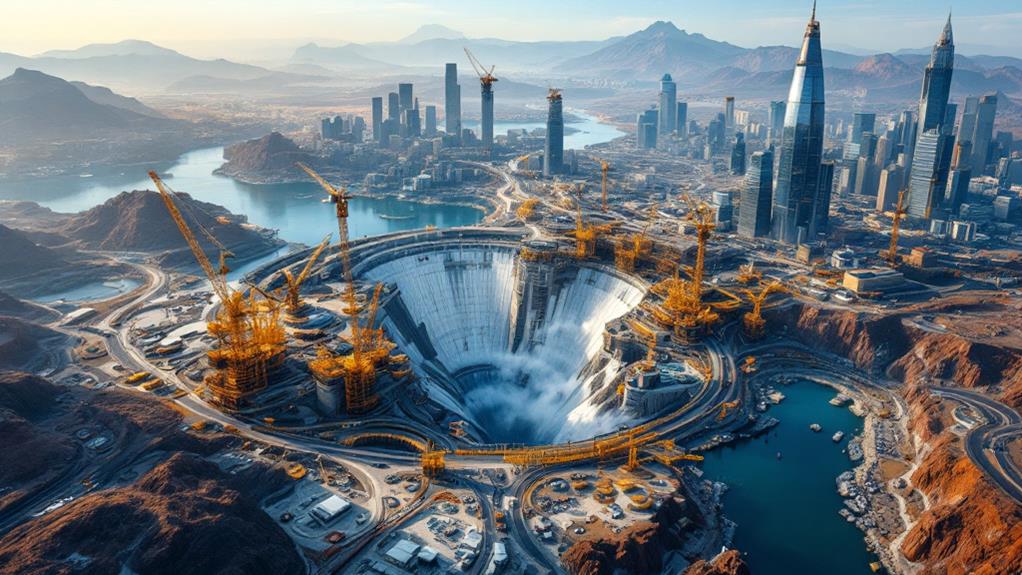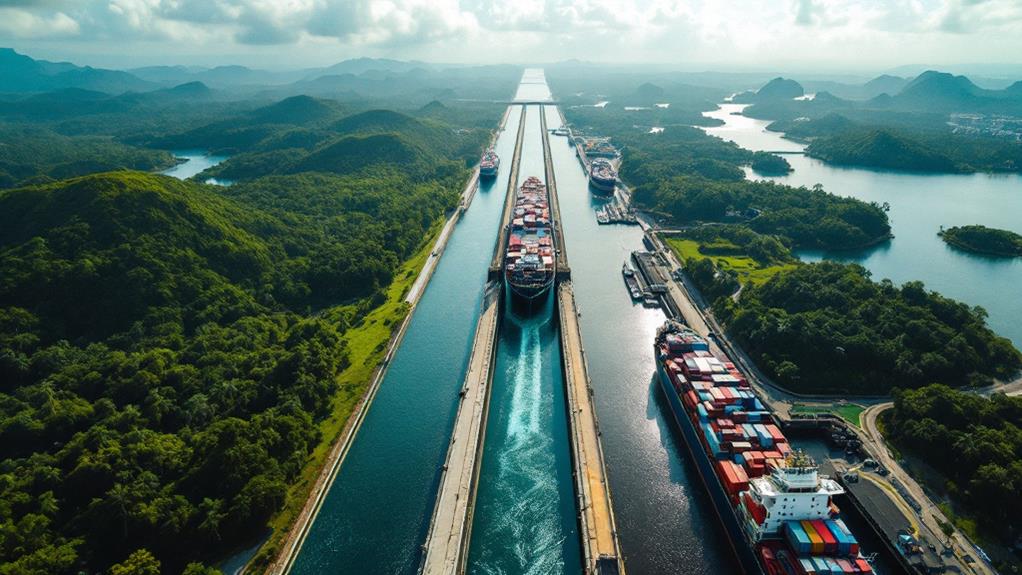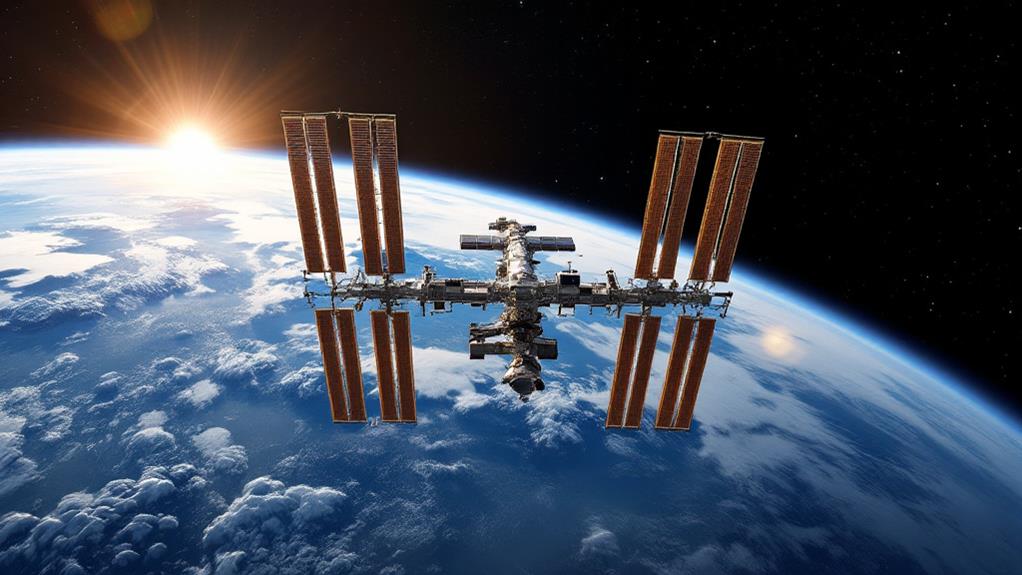The Largest Construction Projects in History: Engineering Marvels Around the World

When you think of the largest construction projects in history, an odyssey of human determination unfolds. The Great Wall of China stretches thousands of miles, symbolizing resilience. The Pyramids of Giza display ancient Egypt's precision and ambition. Modern marvels like the Panama Canal and Channel Tunnel redefine global trade and connectivity, overcoming natural and technical hurdles. The Burj Khalifa towers in architectural elegance, while the Three Gorges Dam leads in hydropower. Even beyond Earth's boundaries, the International Space Station represents international collaboration. Each of these extraordinary feats invites you to uncover the stories behind their awe-inspiring achievements.
The Great Wall of China
Spanning thousands of miles, the Great Wall of China stands as one of history's most ambitious construction projects. As you investigate its vast stretches, you'll witness ancient engineering at its finest. Built over several dynasties, the wall wasn't constructed as a single entity but developed over centuries, showcasing the evolution of techniques and strategies. Its primary purpose was defense, protecting the Chinese states from invasions and raids. However, it also served as a symbol of the nation's resilience and ingenuity.
Walking along the wall, you're not just stepping on stones; you're stepping into a significant cultural and historical legacy. The Great Wall represents more than just a barrier; it embodies the cultural significance of unity and strength that has defined China through the eras. Each brick tells a story of the countless laborers who toiled to create this monumental structure.
As you traverse along its expanse, consider the challenges those ancient engineers faced, from harsh terrain to resource scarcity. Yet, they persevered, resulting in a structure that continues to inspire awe. It's a proof of human determination and the profound cultural significance it holds for China and the world.
The Pyramids of Giza
Among the wonders of the ancient world, the Pyramids of Giza stand as a tribute to the skill and ambition of early Egyptian civilization. When you gaze upon these massive structures, you're witnessing some of the finest examples of ancient engineering. Built over 4,500 years ago, these pyramids were constructed with such precision that they continue to baffle modern engineers and architects.
To understand their construction techniques, imagine the sheer effort involved. Initially, the Egyptians quarried massive limestone blocks, each weighing several tons. You'd then see thousands of workers using sledges and ramps to transport these stones across the desert. The coordination and planning required to align each block so precisely is nothing short of astounding.
As you investigate the Great Pyramid, the largest of the trio, consider how its builders managed to create such perfect geometry. They employed simple tools like plumb bobs and sighting rods, yet achieved remarkable accuracy. This feat required not only manual labor but also an advanced understanding of mathematics and astronomy.
In essence, the Pyramids of Giza aren't just monuments; they're a reflection of the ingenuity and determination of a civilization that mastered ancient engineering long before modern technology existed.
The Panama Canal

While the Pyramids of Giza reflect ancient engineering prowess, the Panama Canal embodies modern innovation and ambition. Imagine standing before this 48-mile-long engineering marvel that reshaped global trade routes. As you investigate its history, you'll appreciate how the canal's creation marked a crucial shift in maritime navigation by connecting the Atlantic and Pacific Oceans. The economic impact of the Panama Canal is profound, drastically shortening sea voyages and enhancing international commerce.
As you examine its construction, consider these fascinating aspects:
- Ingenious Design: The canal's lock system is a masterpiece, lifting and lowering ships over the Isthmus of Panama.
- Massive Scale: Over 60 million pounds of dynamite blasted through mountains to carve this waterway.
- International Collaboration: While initiated by France, the United States completed the project, showcasing global cooperation.
- Environmental Considerations: Workers battled tropical diseases and challenging terrains, highlighting significant engineering challenges.
The Panama Canal exemplifies human determination and ingenuity in overcoming nature's obstacles. Its construction was fraught with difficulties, yet the canal stands as a representation of what can be achieved with perseverance and vision. When you consider its legacy, you're reminded of its enduring impact on global trade and the engineering expertise that brought it to life.
The Channel Tunnel
With the Channel Tunnel, you've got a stunning example of engineering that connects two nations under the sea. This impressive feat links the UK and France, creating a crucial transportation corridor that blends innovation with functionality. Imagine the tunnel construction process—drilling beneath the English Channel, a task that required unparalleled precision and collaboration. It's an underground marvel stretching about 31 miles, making it one of the longest tunnels in the world.
As you explore the engineering challenges, you'll find that creating the Channel Tunnel wasn't just about digging. Engineers had to overcome significant geological and logistical hurdles. The seabed's varying rock types meant constant adjustments to drilling techniques. Furthermore, ensuring the tunnel's safety posed another layer of complexity. The engineers employed advanced technology to monitor and maintain structural integrity, mitigating risks from water pressure and potential leaks.
You can appreciate the coordination it took to align efforts between two countries, each with its own regulations and standards. Despite these obstacles, the Channel Tunnel stands today as a reflection of human ingenuity and determination. Next time you think of traveling between Britain and France, remember the incredible engineering that makes it possible.
The Burj Khalifa

As you marvel at the engineering triumph of the Channel Tunnel, turn your gaze skyward toward the Burj Khalifa, an architectural phenomenon soaring above Dubai. This iconic skyscraper, standing at an impressive 828 meters, is not just the tallest building in the world but also a masterpiece of modern engineering and design. The Burj Khalifa architecture combines sleek lines with a robust structure, designed to withstand the harsh desert winds and temperatures.
When you visit, you're not merely seeing a building; you're experiencing an embodiment of human ambition and innovation. Burj Khalifa tourism offers a variety of experiences:
- Observation Decks: Ascend to the 148th floor and enjoy breathtaking panoramic views of the city and beyond.
- Dining: Savor world-class cuisine at stunning heights, with restaurants offering diverse culinary delights.
- Art Installations: investigate curated art pieces that adorn the interiors, enhancing your visit with cultural richness.
- Fountain Shows: Witness the spectacular performances of the Dubai Fountain, set against the backdrop of the towering structure.
As you stand beneath this architectural marvel, you'll appreciate how the Burj Khalifa transforms Dubai's skyline and redefines the boundaries of architecture and tourism.
The Three Gorges Dam
The Three Gorges Dam stands as a monumental achievement in hydroelectric engineering and a demonstration of human ingenuity. Located on the Yangtze River in China, this massive structure is the world's largest power station regarding installed capacity. When you think about hydroelectric power, this dam should be at the forefront of your mind. It generates an incredible amount of electricity, providing power to millions of homes and greatly reducing China's reliance on fossil fuels.
However, you can't overlook the environmental impact of such a colossal project. The dam's construction and operation have dramatically altered the local ecosystem. It flooded vast areas, displacing over a million people and submerging numerous towns. The water quality in the reservoir has been a concern, and the dam has disrupted the natural migration patterns of fish and other aquatic life. Despite these challenges, the Three Gorges Dam remains a marvel of modern engineering, balancing the benefits of clean energy with its ecological footprint. As you investigate the world's largest construction projects, remember the lessons learned from this iconic dam and the ongoing dialogue it sparks about sustainable development.
The International Space Station

Shifting our gaze from the wonders of Earth to those orbiting above, consider the International Space Station (ISS), another pinnacle of human achievement. As the largest human-made structure in low Earth orbit, the ISS serves as a symbol of international cooperation and the relentless pursuit of space exploration. You can appreciate its complexity by understanding that it moves at a breathtaking speed of about 17,500 miles per hour, completing an orbit around Earth roughly every 90 minutes. This is where orbital mechanics come into play, ensuring the station remains in a stable orbit, a feat of engineering that requires precise calculations and adjustments.
When you think about the ISS, keep in mind these fascinating aspects:
- International Collaboration: Over 15 countries contributed to its construction and operation, a symbol of global unity.
- Continuous Human Presence: Since November 2000, astronauts have lived and worked aboard the ISS, conducting experiments that benefit life on Earth and beyond.
- Modular Design: Built in pieces and assembled in space, its modular nature allows for ongoing upgrades and expansions.
- Scientific Research: The ISS is a floating laboratory, enabling research in microgravity that's impossible on Earth.
The ISS isn't just a marvel of construction—it's a lighthouse of human potential in space exploration.



